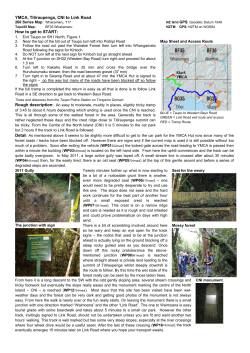
SAMPLE REGISTRATION FORM: New G@GPS Groundwater Basin
SAMPLE REGISTRATION FORM: New G@GPS Groundwater Basin (available at: http://www.gw-gps.com/register-new-basins/) Why register groundwater basins with G@GPS? G@GPS is an open network that welcomes anyone in any part of the world to register groundwater basins. Registration of basins is free and helps with two critical components of G@GPS’s Mission. First, registration of basins helps to formalize the network of scientists and improve the flow of information. Second, registration of basins helps G@GPS to correlate data from different parts of the world in order to identify recharge periods and better understand climate signals in groundwater. How to register groundwater basins with G@GPS? Please fill in the registration form below and email it to Jason Gurdak (jgurdak@sfsu.edu) who will publish it on this G@GPS webpage. Ideally, all data should be stored in an ArcGIS database. The scientists are responsible for the data in their individual basins and can contact scientists working in other basins when there is a need for exchange of data or expertise. Sample: Main responsible scientist(s) (names, affiliation, postal address, email address): Lizete Dias, Ara- Sul, ldias@ara-sul.co.mz Mussa Achimo, Univ. of Eduardo Mondlane, Department of Geology, achimo.mussa@gmail.com Elónio Muiuane, Univ. of Eduardo Mondlane, Department of Geology, muiuane@zebra.uem.mz Name of the basin: Maputo Groundwater Basin Geographic area: Mozambique, Maputo Province (enclose a map): Size (km2): 4847 Brief geological description (enclose relevant figures): Phreatic sand aquifer variable thickness (0100m)overlying confining layers of sand. The clay overlies sandstones, which form semi-confined and confined aquifers with an average thickness of ca 50 m Existing geological/geochemical data (type of data, published/unpublished) A. Geoelectrical profiles B. Boreholes C. Electrical conductivity measurements in all wells D. Analyses of main cations and anions, nitrate of samles from all wells Plans for G@GPS-related studies: Analysis of stable isotopes (oxygen and hydrogen) of samples from all boreholes, both phreatic and confined aquifers. Earlier studies (references to published papers): Elónio Muiuane: The Quality of Groundwater in and around Maputo city, Mozambique. Report UEM. Dinis Juízo and Nelson Matsinhe Water services in peri-urban areas of Maputo city with private sector participation Report UNESCO IHE Range of groundwater ages found (if any study available): No age determination done Palaeoclimate data from the area (ongoing and published): Partridge, T.C., 1997. Cainozoic environmental change in southern Africa, with special emphasis on the last 200 000 years. Progress in Physical Geography 21, 3-22. Partridge, T.C., Scott, L., Hamilton, J.E., 1999. Synthetic reconstructions of southern African environments during the Last Glacial Maximum (21e18 kyr) and the Holocene Altithermal (8e6 kyr). Quaternary International 57-58, 207-214. Peltier,W.R., 2002. On eustatic sea level history: Last Glacial Maximum to Holocene. Quaternary Science Reviews 21, 377-396. Ramsay, P.J., 1995. 9000 years of sea-level change along the southern African coastline. Quaternary International 31, 71-75. Ramsay, P.J., Cooper, J.A.G., 2002. Late Quaternary sea-level change in South Africa. Quaternary Research 57, 82e90.
© Copyright 2025





















